Slate roofs, cherished for durability and beauty, showcase exceptional craftsmanship in roofing. This metamorphic rock, sourced from the earth, provides centuries of home protection and a lasting legacy. Its lifespan often exceeds a century, appealing to homeowners seeking elegance and functionality. Yet, understanding slate’s virtues is crucial for potential buyers and owners.
What is Slate Roofing?
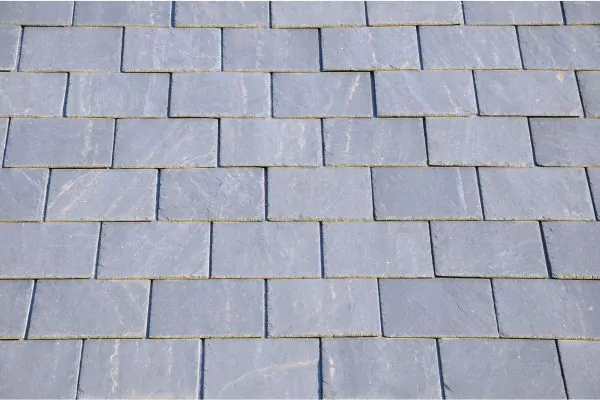
As a roofing material with a storied lineage, slate has captivated homeowners and roofing contractors alike with its classic elegance and durable nature. Emerging from the intense transformation of sedimentary rock, it becomes robust and prized for roofing. Distinguishing between natural and synthetic slate is crucial for homeowners. Both offer distinct benefits, guiding roofing choices and advising clients on their building’s crown.
Exploring the origin and geological formation of slate
Slate owes its existence to the relentless forces of nature that gradually transform clay and volcanic ash into sedimentary rock, subsequently altered under high pressure and modest heat to manifest as this fine-grained, and foliated metamorphic wonder. The delicate dance of the earth’s tectonics, paired with the intricate processes of metamorphism, gives birth to the layered character of slate which makes it an exceptional choice for roofing tiles.
Differentiating between natural and synthetic slate roofing
The marketplace showcases a choice between authentic slates pulled from the earth – boasting a lineage tracing back to Spanish and North Wales quarry traditions – and modern synthetic slates, a concoction of resin and natural stone particles. While the true slate carries a narrative of geological marvel and a higher cost reflective of its endurance and fire resistance, the synthetic alternative appeals with its cost-effectiveness and a lighter load, reducing stress on a structure’s framework without forsaking the slate’s classic profile.
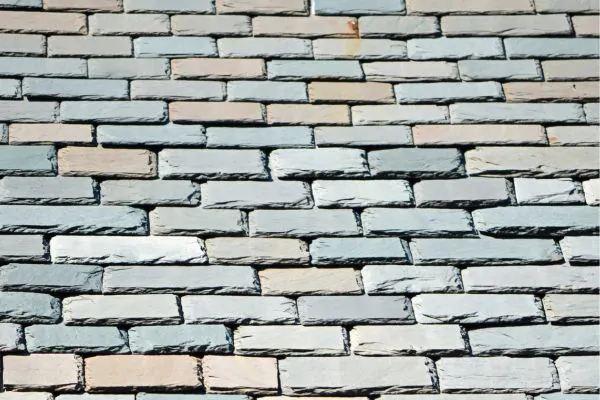
Pros of Slate Roofing
Slate roofing embodies a trio of key advantages highly valued by property owners and experts. Its inherent strength serves as a stalwart shield against various weather conditions, ensuring protection from rain, wind, and other elements. Known for longevity, slate roofs often outlast generations, proving a sound property investment.
1. Durability: How slate withstands harsh weather conditions
The impervious slate roof effortlessly shrugs off the fierce lashings from storms, its low water absorption rate thwarting water damage and frost damage that often plagues other roof materials. Its dense, hardwearing nature serves as a shield, granting the building beneath peace of mind against the relentless challenges posed by Mother Nature, from scorching sun to freezing snowfall.
2. Longevity: The lifespan of a well-maintained slate roof
Slate endures, boasting exceptional longevity in roofs, lasting over a century when well-maintained. Its enduring strength and beauty create a legacy for residents seeking permanence. Unlike asphalt shingles which need replacement every 20-30 years, slate roofs reduce the frequency of installations significantly. Contractors emphasize slate’s timeless charm and low maintenance, appealing to buyers for long-term financial and aesthetic benefits.
3. Energy efficiency: Insulating properties of slate
The heavyweight contender in the ring of thermal efficiency is the slate tile. This natural material serves as an excellent insulator, keeping interiors cool in summer and warm in winter, thus functioning as a steward of energy conservation. Such insulating efficiency is due not only to slate’s density but also to its ability to reflect solar heat, contributing to energy savings for the homeowner throughout the changing seasons:
- Slate’s natural thermal mass regulates indoor temperatures, reducing reliance on artificial cooling and heating systems.
- Roofing companies often promote slate for its inherent ability to maintain climate control within homes, potentially lowering utility bills for residents.
- With the ease of maintenance and energy benefits, slate roofing stands as a sound choice for those looking to enhance their building’s green credentials and curb appeal.
Desventajas de los Techos de Pizarra
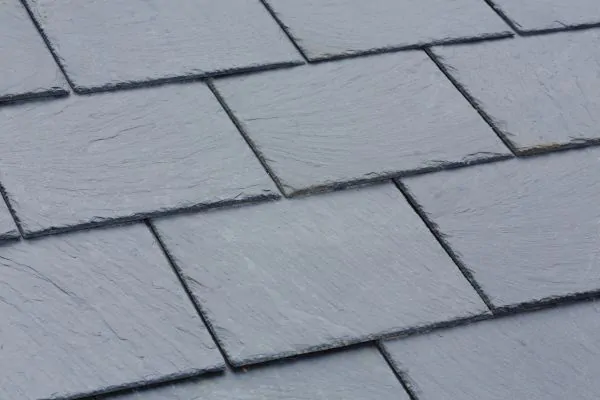
Choosing a slate for a roof involves weighing its strengths and challenges. Homeowners must consider the material’s impact on a building’s integrity, installation complexity, and maintenance costs. Slate’s weight, installation expertise, and repair needs warrant careful planning and knowledgeable roofing contractors, anticipating potential challenges and increased expenses.
1. Weight considerations and structural implications
One cannot overlook the innate heftiness of slate when considering it for roofing purposes; the substantial weight demands a robust structural support system to bear its load. Spans and trusses must be analyzed and, if necessary, fortified by a structural engineer to ensure the building can endure the long-term demands of a heavy slate roof without compromising integrity.
2. Installation challenges and associated costs
The complexity inherent in slate roof installation demands a mastery that only seasoned installers possess, often translating into higher labor costs for the homeowner. Talented installers must delicately balance the fragility of each slate tile with skilled precision to prevent damage during the installation process, an expertise that bears a price reflecting the level of skill and experience required.
3. Potential for breakage and difficulty in repair
Homeowners must acknowledge the slate’s susceptibility to breakage despite its roofing advantages. While durable against the elements, slate shingles may crack from storm debris or incorrect walking. Finding a skilled roofer for seamless repairs proves challenging. Specific tools and expertise are vital for effective and aesthetically pleasing fixes. Matching slate for repairs poses difficulty due to natural variations or discontinued products, affecting color and texture.
Related Post: Different Types of Roofing for Homeowners
Considerations for Prospective Slate Roof Owners
For those eyeing slate roofing, financial planning is crucial. Balancing upfront costs against long-term savings is key. Consideration of slate’s impact on resale value, offering protection, is vital. Its eco-friendly nature due to longevity and energy efficiency appeals to environmentally conscious buyers. These factors shape decision-making, guiding homeowners toward an investment aligned with their finances and values.
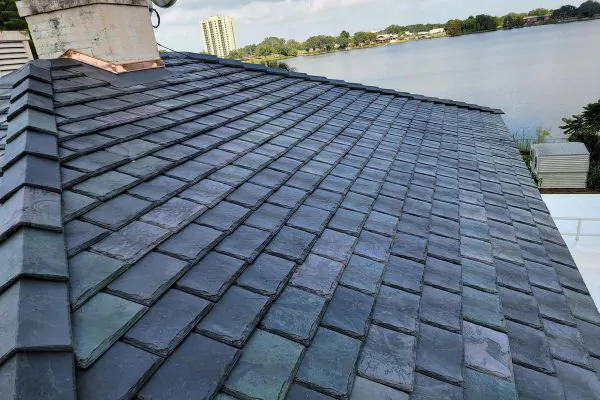
Budget considerations: Initial costs vs. long-term savings
When deliberating the fiscal aspects of slate roofing, potential homeowners must balance the initial investment against the enduring advantages slate offers. While the upfront costs of a slate roof are typically higher, reflecting sourcing and labor expenses, the lifespan and energy savings associated with slate often equate to significant long-term financial benefits.
- Evaluate the initial costs of materials and specialized installation for a slate roofing system.
- Consider the longevity of slate, which can translate to infrequent roof repairs and replacement over time.
- Factor in potential energy cost savings due to the insulating properties of slate roof tiles.
Impact on home resale value and curb appeal
A slate roof’s influence on a home extends beyond mere functionality; it significantly enhances the structure’s marketability and aesthetic appeal. The stately appearance of slate roof tiles contributes to the property’s appeal, potentially increasing its resale value as buyers often perceive slate roofing as a sign of luxury and longevity. Roofing contractors frequently tout the transformative effect of slate on a home’s exterior as a selling point, asserting that the sophisticated touch it adds makes a property stand out in any neighborhood.
Eco-friendly aspects of slate roofing materials
The ecological footprint of slate roofing materials is minimized through their source material’s durability and longevity, and slate’s inherent strength prevents frequent replacements, thereby reducing the waste that accumulates in landfills. As slate is a natural stone, its extraction and production process is less reliant on synthetic components, offering an eco-superior alternative to other, more carbon-intensive roofing solutions like asphalt shingle roofs or rubber roofs.
Expert Tips for Installation and Maintenance
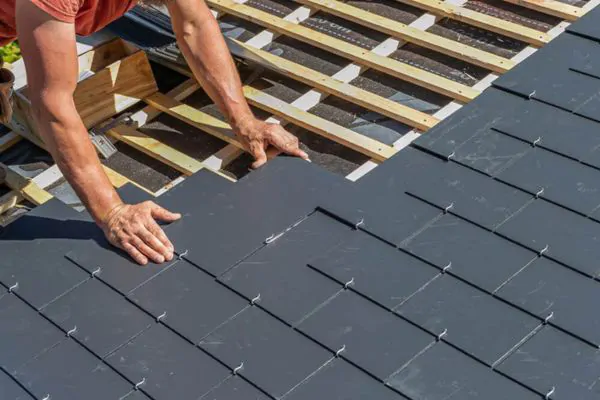
Adorning a structure with a slate roof demands careful planning for enduring longevity and aesthetics. Skilled installation is crucial, blending artistry and technical expertise for structural integrity and longevity. Regular maintenance is equally vital to preserve its splendor and strength. Expert insights highlight the importance of an adept roofing company and cornerstone practices that fortify a slate roof’s resilience.
Slate’s natural origin offers an eco-friendly alternative, reducing reliance on synthetic materials like asphalt or rubber roofs. Its low water absorption and temperature resistance minimize damage, promoting sustainability and an environmentally conscious roofing choice.
- Hiring professionals for proper slate roof installation
Selecting an experienced roofing contractor is pivotal for a successful slate roof installation, as the precision required in handling and fitting slate tiles demands a high level of expertise. The right professional ensures that the roof’s integrity and aesthetic appeal are established from the outset, resulting in a roof system that not only enhances the building’s appearance but also provides robust protection for decades.
- Regular maintenance routines to enhance longevity
Maintaining the integrity of a slate roof hinges on routine check-ups and cleanings, conducted by professionals skilled in spotting early signs of roof damage before they evolve into costly repairs. Through these regular maintenance schedules, homeowners not only preserve the structural soundness and visual appeal but also ensure the longevity of their slate roof, solidifying its status as a generational investment.
Consult Our Slate Roofing Experts Today!
Embarking on the journey to equip a home with a slate roof is an exercise in balancing elegance with practicality. This guide has traversed the multifaceted landscape of slate roofing, from its geologic wonders and visual allure to pondering its substantiality and maintenance requisites. Recognizing the magnitude of such a decision is paramount; it requires a well-informed evaluation of the myriad factors influencing both immediate and enduring outcomes.
You might like: 7 Reasons To Hire A Professional Roofing Company
Recap of the key points discussed in the guide
This guide offered a comprehensive examination of slate roofing, detailing the origins and features of both natural and synthetic slate, the merits of durability, longevity, and energy efficiency it brings to a home, and the considerations necessary for structural requirements and financial planning. It emphasized the importance of expert installation and regular maintenance to maximize the lifespan and function of a slate roof while underscoring the material’s beauty and eco-friendly attributes that contribute to a property’s value and curb appeal.
Emphasizing the importance of informed decision-making
In any slate roofing endeavor, the value of informed decision-making cannot be overstated, as it guards the homeowner against unforeseen expenses and structural challenges. Aligning with an esteemed slate roofing company ensures a homeowner receives not only top-tier materials and craftsmanship but also critical guidance through the intricate terrain of options, costs, and maintenance. It’s this thoughtful approach, empowered by expertise and foresight, that transforms a vision of roofing excellence into a resilient and radiant reality.
Frequently Ask Questions
1. Can you walk on a slate roofing?
Walking on a slate roofing is generally not recommended because slate tiles can crack or break under pressure. If maintenance is needed, it’s best to hire a professional with experience in handling slate roofs, as they have the right tools and techniques to avoid damaging the tiles.
2. Is a slate roof worth the money?
Slate roofing is worth the investment for its durability, long lifespan, and classic look. Although costly upfront, it can last over a century, saving on replacement costs and potentially lowering energy bills.
3. What is the lifespan of slate roofing?
A well-maintained slate roofing can last over 100 years, making it one of the most durable roofing materials available. Its resistance to weather ensures longevity far beyond that of typical roofing materials.
4. Do slate roofs need underlayment?
Yes, underlayment is recommended as it provides extra moisture protection, particularly in heavy rain or snow areas. Quality underlayment helps maintain the roof’s integrity over time.
5. Does slate roofing increase home value?
Yes, slate roofing can boost home value due to its long lifespan, energy efficiency, and high-end appearance. Buyers often view it as a luxury feature that adds curb appeal.
Conclusion
Summing up, slate roofing combines beauty, durability, and eco-friendliness, making it an ideal choice for homeowners. Rooted in geological history, slate ensures longevity, energy efficiency, and increased property value. Despite its weight and installation cost, slate’s enduring quality justifies initial investments. Regular upkeep secures its legacy, promising generational protection. Expert guidance is key for maximizing the full benefits of this timeless roofing material.
Contact us today and get a free quote for your roofing project!



